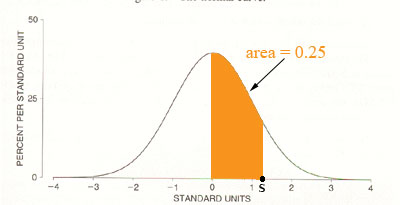| |||
| Math Central | Quandaries & Queries |
|
Question from Justin, a student: Hello, Here is the question: I'm fairly certain the problem is actually solvable because we have the standard deviation. I just don't understand how to solve for it with the seemingly limited information in the problem. Solving for Z comes to mind, but there doesn't seem to be enough information. Thanks for your help! -Justin |
Hi Justin,
Changing the problem to a problem using the standard normal random variable Z is the right way to go. The conversion is ![]() which in your case is
which in your case is ![]() .
.
Your probability statement P(20 ≤ Y ≤ 60) = 0.50 can be represented graphically by

Notice that the shaded area is symmetric about the mean 40 so P(40 ≤ Y ≤ 60) = 0.25.
Now convert to the standard normal distribution and the diagram becomes

(I only brought across half of the shaded region because most of the standard normal tables I have seen make it easy to deal with areas between Z = 0 and Z = some positive number.) The point s on my diagram is the converted value for Y = 60, that is ![]() .
.
Use the normal table to determine the value of s, substitute into the equation above and solve for σ.
Harley
 |
||
Math Central is supported by the University of Regina and The Pacific Institute for the Mathematical Sciences.